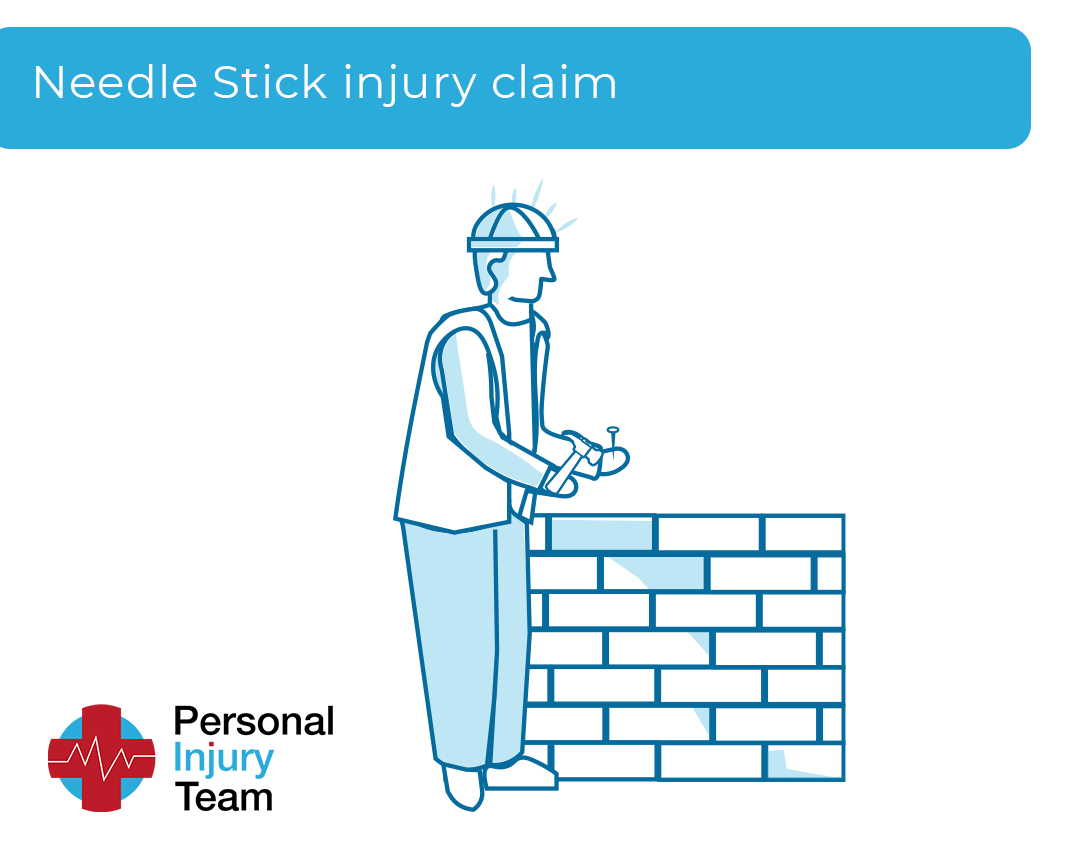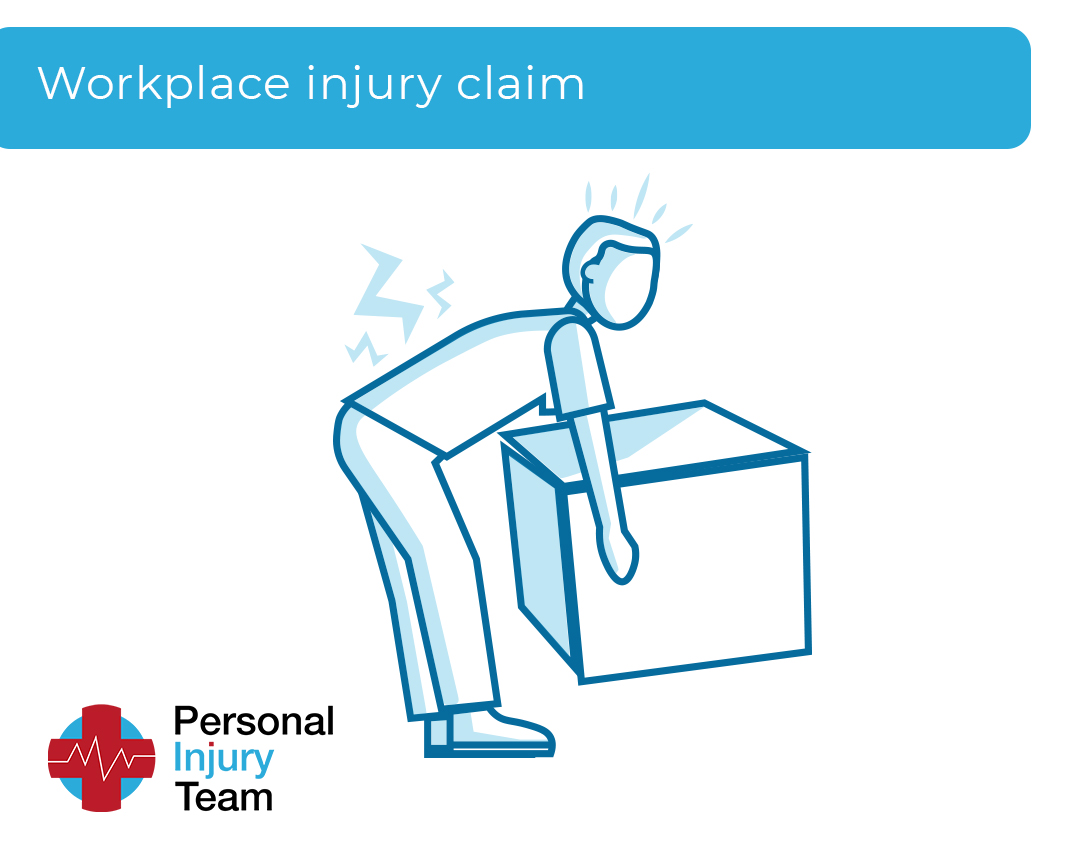A needle stick injury claim seeks compensation for the damages you suffer from getting stuck by a sharp object. The contaminated sharp instrument is usually a medical device but can be a drug user’s syringe or a dirty knife at work.
Needle stick injury is also known as a sharps injury and is a workplace accident. You should contact an accident at work personal injury solicitor when you suffer one, as you may have a claim for compensation.
Your personal injury solicitor seeks to recover damages through a claims process. If you have been injured, and your life impacted by an accident that was someone else’s fault, a claim for compensation seeks financial redress for your injuries and financial losses.
If you have been injured in an accident and it was not your fault, The Personal Injury Team No Win No Fee solicitors will file your compensation claim and get you the money you deserve.

Table of content
What is a needle stick injury claim?
A needle stick injury claim is when you seek damages from the party responsible for the injury. Someone did not dispose of the sharp, contaminated instrument correctly, and their negligence could be responsible for your needle stick injury.
You can also look to start a needle stick injury claim if you suffer one when your employer has not supplied protective gloves and clothing.
Most needle stick injuries are minor puncture wounds to a finger or palm of the hand. The real danger is contracting a disease from the contaminated needle or scalpel. If you suffer a needle stick injury and contract a disease, you may be in line for personal injury compensation.
A needle stick injury claim seeks compensation for the exposure to blood viruses from the contaminated sharp instrument. Your claim is for the damages of contracting the virus, the financial losses and the effects on your life.
A No Win No Fee personal injury solicitor brings your needle stick injury claim against those responsible for the workplace negligence.
Common needle stick injuries
Common needle stick injuries come from being stuck by any sharp object, such as an unprotected needle or a scalpel left exposed in the workplace.
There are protocols for disposing of sharp medical and industrial instruments; when they are not followed, you could get a needle stick injury.
Common needle stick injuries are:
Needle stick injury from a medical device claim
A needle stick injury from a medical device is a very common injury. The doctor or nurse throws a used needle in the wrong bin, and another hospital worker gets stuck by it.
A needle or scalpel left unattended and uncapped on a shelf or tray can easily stick into someone’s hand, even if they are wearing gloves.
The fear and upset of getting stuck by a contaminated medical needle or scalpel is very distressing and will form part of your claim for damages.
Needle stick injury from a vet’s needle claim
A needle stick injury from a vet’s needle happens on farms and equestrian centres. A vet or veterinary nurse leaves a used needle uncapped, and a farm worker cuts themselves on it.
Farmers often inject an animal without the need for a vet. If they do not dispose of it properly, the needle or used scalpel can cut anyone cleaning the area later.
Needle stick injury from construction material claim
Needle stick injury from construction material can happen with discarded window glass, old rusted metal and sharp pieces of broken concrete or floor tiles.
The construction material should be disposed of properly, and anyone coming in contact with it should be fully trained and wearing protective gear.
Needle stick injury from razor blades claim
Needle stick injury from razor blades is seen in medical settings, animal health centres or even at the hairdressers and barbers.
Razor blades not disposed of properly are a hazard to staff and refuse collectors.
The used razor blade could carry infection, body fluids and dried blood.
Needle stick injury from lab glass claim
Needle stick injury from lab glass comes from broken research instruments, which can be very sharp and easily cut the skin.
Lab glass can carry bacteria, toxic substances and blood or body fluids.
Needle stick injury from a discarded syringe claim
Needle stick injury from a discarded syringe is a hazard for council workers and those in the refuse industry. A used syringe may be left in a plastic bag, in a bin, or on the open ground or footpath.
When not wearing gloves and protective clothing, the worker clearing an area or emptying bins can easily get a needlestick injury.
Who is at risk of a needlestick injury?
Workers in many industries are at risk of a needlestick injury. It could be the doctor in a busy A&E ward, the farm labourer cleaning a stable or the building site worker while clearing a site.
Employees are a high risk for a:

Construction
The construction industry has many needle stick hazards, such as broken glass and sharp materials.
Factories
Factories have sharp instruments which can carry infection. Workers are exposed to blades, glass and tools which can cut and penetrate the skin.
Council services
Council services workers deal with waste in the local parks and streets and often suffer needle stick injuries from discarded needles and blades.
Farming
Farming has needle stick hazards such as used and uncapped syringes, blades and scalpels left behind by the vet or the veterinary nurse.
Waste disposal
Waste disposal involves refuse sacks, bins and unsorted materials which contain needles, sharp instruments and broken glass, which can break the skin and infect the worker.
The police and prison services
The police and prison services deal with drug addicts, and officers can get a needle stick injury when searching a prisoner or arresting someone on the street.
Research laboratories
Research laboratories have many hazardous materials, such as blood and bodily fluid samples. An employee can get a needle stick injury from broken glass or other sharp material in the lab.
Why is a needle stick injury so dangerous?
A needle stick injury is so dangerous as you can easily contract an infection from the syringe needle, scalpel or other sharp material that pierces the skin.
A syringe needle discarded in the local park may carry HIV, Hepatitis B or C, or any one of the many transmissible infections carried in the blood.
Hospital waste, such as needles and scalpels, could carry any infection from HIV to retroviruses and even rare diseases which you wouldn’t usually be exposed to outside of a medical setting.
Veterinary equipment can carry transmissible diseases such as blood poisoning and toxoplasmosis, which could damage the liver and eyesight and cause serious illness.
Construction material can carry infection, and tetanus is a common condition seen after cuts from jagged steel and discarded floor tiles.
There are more than 20 blood-borne pathogens that can live on discarded needles and other sharp objects from hospitals and doctors’ surgeries.
You may be exposed to infection and nasty diseases when you suffer a needle stick injury. Some infections can be life-changing, and waiting to hear back on blood tests can be very stressful.
If you suffer a needle stick injury, your No Win No Fee solicitor can bring a needle stick injury claim for compensation against the responsible party.
Compensation for a needle stick injury
The amount of compensation awarded depends on the injury and the financial costs of its effect on your life.
Compensation amounts for a needle stick injury:
Our Process
We make the claim process as simple and streamlined as possible, and that’s one of the reasons we’re maintain a 4.9 / 5 ★ rating from our customers!
Enquiry
The first step is to get in touch and tell us what went wrong. It’s free and easy. Call our 24-hour helpline: 0800 027 0370 or request a callback here.
Claim Evaluation
Once you have spoken with our team we’ll let you know how we can help. This will involve a thorough case review and understanding of the incident, financial damages and physical injuries.
Legal Letter
Once we are satisfied we have all the information we require and have a full understanding of your circumstances. We send a letter of claim to the negligent party outlining your claim and compensation requirements.
Who pays my compensation for a workplace injury claim?
The negligent party’s insurance company usually pays your compensation in a valid needle stick injury claim. If the needle stick injury is not your fault, the negligent party should pay for your injury, recovery, and all your financial losses now and in the future.
Your employer is responsible for providing you with protective gloves, boots and other gear if you work with hazardous waste. The company is also responsible for ensuring you receive full training in wearing the gear and in handling dangerous material.
If you are injured when working for the NHS, you may be able to make a claim against the NHS as it owes you a duty of care as an employee.
The employer is also responsible for your ongoing training and for dealing with your injury when it happens to you at work.
If you are injured at work, you might be able to make a claim for personal injury against your employer and their insurance company.
Make a Needle Stick Injury claim today
Find out how much you can claim in compensation for needle stick injury today. Take the Personal Injury Team FREE online assessment to speak with a member of our team.
Compensation amounts for Needle Stick injuries are guidelines on what to expect from your personal injury claim.
Our personal injury solicitors can advise you using their expertise and experience and can quickly tell you if you have a valid claim and what to do next.
If you have been the victim of a breech to the Health and Safety at work act 1974, contact your Personal Injury Team today for immediate expert advice tailored to you.
Find out how much you can claim today with a No Win No Fee Personal Injury Solicitor.

Social services
Social services employees deal with drug addicts who carry old needles and leave them exposed in their rooms or luggage.